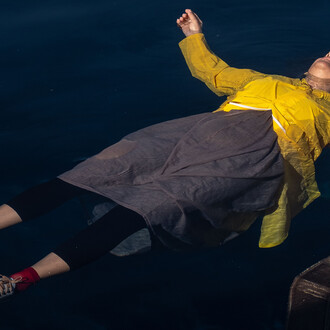Gladstone Gallery is pleased to present in beauty bright, its first exhibition by Ugo Rondinone in Seoul. On view from August 29 to October 18, the show features thirteen new landscapes in various sizes. Each work is a watercolor on canvas in its own arrangement of the same five pastel shades— pink, blue, yellow, purple, and green. Otherwise, the compositions are identical, using only four lines to depict a mountain lake.
The exhibition’s title comes from William Blake’s lullaby “A Cradle Song” from his 1789 collection Songs of innocence. It opens:
Sleep, sleep, beauty bright,
Dreaming in the joys of night;
Sleep, sleep; in thy sleep
Little sorrows sit and weep…
The artist’s bright palette—heightened by the gallery’s grey walls—draws on colors traditionally associated with babies and small children, first in North America and Western Europe, and increasingly worldwide. Soft pink and light blue are the familiar gendered colors for girls and boys, while yellow has long been used for pre-birth gifts when the child’s gender is unknown. Purple and green, in the contemporary shades of children’s toys, complete the scheme. The choice of colors, it should be noted, coincides with the recent birth of the artist’s child.
Since the spring of 1989 at the height of the AIDS crisis when so many around him were losing their lives to the disease—making him keenly aware of his own mortality—every painting Rondinone has made has taken the date of its completion for its title. This direct association with time joins another feature that all his paintings also share: the depiction of a space that can be entered visually. As a result of the pairing, each work becomes emblematic of life as the marriage of space and time. Rendered in a string of letters the length of an alphabet, or of an incantation, the titles are in German, the predominant language of Rondinone’s native Lake Lucerne region of central Switzerland. Born there in 1964, he grew up surrounded by nature on the shores of the famous alpine lake. References to the natural world—the world of life—recur throughout his diverse oeuvre, though naturalism itself is not among its traits. Rather, he is known for a poised synthesis of nature and culture where both dimensions have equal weight.
Indeed, synthesis seems to be a leitmotif in these painted variations—uniting the personal and the universal, figuration and abstraction. We could add the synthesis of mass production and unique handcraft through industrial colors and repetitive compositions that are clearly made by hand.
In light of the artist’s recent life event, one might also think of a child as the synthesis of its parents. Similarly, these works are offspring, in a sense, of a monumental diptych—a two-sided watercolor on canvas, identical to them in composition and subject, depicting the stylized view of the lake as seen from Lucerne proper. In varying shades of blue arranged to suggest day or night, the giant back-toback pictures were first shown in Rondinone’s 2024 survey at the Kunstmuseum Luzern, only a few feet from the lake they portray. In the subsequent smaller works, the cycling of industrial colors and the variation in size create the pulsing, kinetic effect of Op Art.
Attentive viewers of these color-saturated canvases will also detect a nod to Color Field painting, particularly Helen Frankenthaler’s influential staining technique. At the same time, minimalism— historically a reaction against Color Field—is evoked through the extremely reductive format: an instantly recognizable subject rendered with the simplest means, four lines dividing five planes. A margin of raw canvas further resists the illusionism of traditional landscape painting.
Local audiences will recall Rondinone’s recent major exhibition at Museum SAN. They may also recognize a kinship with the Dansaekhwa tradition, which synthesises Korean heritage with modernist form. Rich with echoes of earlier art despite their distilled simplicity, these cheerful new works by a generation-defining artist are in a similar spirit.
(Text by Marc Mayer)














